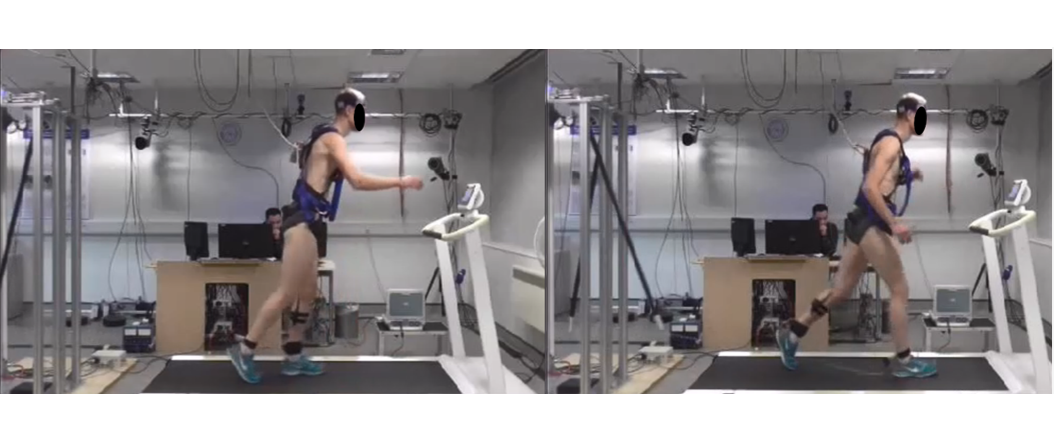
Research
Research Themes
Laboratories
The Research Group of Movement and Exercise Sciences (MoveEx) at the University of Koblenz, in collaboration with the Faculty of Mathematics and Technology at the University of Applied Sciences Koblenz, Campus Remagen, and the Biomechanics Research Team at London South Bank University, operates several laboratories with state-of-the-art facilities for both basic and applied science. One of the key laboratories, covering 200 square meters, is located at the RheinAhrCampus Remagen. It is equipped with two motion capture systems (Qualisys and Optitrack) featuring 29 cameras, two Xsens motion capture suits, and an instrumented BERTEC treadmill for measuring 3D ground reaction forces during locomotion.
Additional cutting-edge equipment includes four portable B-mode ultrasound devices, four portable force plates, one pressure plate, a telemetric EMG system with 16 channels, and multiple VR and AR glasses. The laboratory also features various mechatronic devices (dynamometers) and embedded systems designed for the in vivo assessment of muscle and tendon mechanical properties. These are complemented by automatic post-data processing and report generation tools used in research-service projects.
MoveEx also incorporates a mobile muscle-tendon laboratory system (TEMULAB), which enables real-time and remote assessments of muscle and tendon properties outside traditional laboratory environments - ideal for clinical and sports applications. Additionally, a mobile 15-meter gangway equipped with sensor-based controllers can be set up to induce predictable and unpredictable slips, trips, and missteps, with an integrated safety harness system. One key tool is a custom-built, pneumatically driven mechanical perturbation device, which uses a break-and-release mechanism to apply controlled perturbations to the ankle or hip, simulating trip- and slip-like events for participants walking on a treadmill. Thanks to collaborations with regional clinics, we have access to 3T MRI scanners for detailed assessments of muscle, tendon, and joint structures, supporting both basic and applied science.
Our mission at MoveEx is to develop and establish non-invasive methods for both healthy and pathological conditions. One of our primary objectives is the construction and development of custom-made mechatronic systems for in vivo assessments. To facilitate this, we have access to a 3D printer for rapid prototyping and a fully-equipped workshop, staffed by mechanical and electrical engineers. We also offer excellent workspaces for postgraduate research students and for visiting scholars.
Publications (selected)
Lambrianides, Y., Epro, G., Arampatzis, A., & Karamanidis, K. (2024). Evidence of different sensitivity of muscle and tendon to mechano‐metabolic stimuli. Scandinavian Journal of Medicine & Science in Sports, 34(5), e14638.
Gießler, M., Werth, J., Waltersberger, B., & Karamanidis, K. (2024). A wearable sensor and framework for accurate remote monitoring of human motion. Communications Engineering, 3(1), 20.
Epro G, Suhr F, Karamanidis K. (2023) Human muscle-tendon unit mechanobiological responses to consecutive high strain cyclic loading. J Exp Biol. 226(20):jeb246507.
Weber, A., Hartmann, U., Werth, J., Epro, G., Seeley, J., Nickel, P., Karamanidis, K. (2023). Enhancement of awareness through feedback does not lead to interlimb transfer of obstacle crossing in virtual reality. J Biomech. 153:111600.
Weber, A., Hartmann, U., Werth, J., Epro, G., Seeley, J., Nickel, P. and Karamanidis, K. (2022). Limited transfer and retention of locomotor adaptations from virtual reality obstacle avoidance to the physical world. Scientific Reports, 12;10: 19655.
Werth, J., Epro, G., König, M., Santuz, A., Seeley, J., Arampatzis, A., Karamanidis, K. (2022). Differences in motor response to stability perturbations limit fall-resisting skill transfer. Scientific reports, 12;1:21901.
Olivera, A. L. P., Solan, M. C., Karamanidis, K., Mileva, K. N., & James, D. C. (2022). A voluntary activation deficit in m. abductor hallucis exists in asymptomatic feet. Journal of Biomechanics, 130:110863
Weber, A., Werth, J., Epro, G., Friemert, D., Hartmann, U., Lambrianides, Y., ... & Karamanidis, K. (2022). Head-Mounted and Hand-Held Displays Diminish the Effectiveness of Fall-Resisting Skills. Sensors, 22;1:344
König, M., Santuz, A., Epro, G., Werth, J., Arampatzis, A., & Karamanidis, K. (2022). Differences in muscle synergies among recovery responses limit inter-task generalisation of stability performance. Human Movement Science, 82: 102937.
Lambrianides, Y., Epro, G., Smith, K., Mileva, K. N., James, D., & Karamanidis, K. (2022). Impact of Different Mechanical and Metabolic Stimuli on the Temporal Dynamics of Muscle Strength Adaptation. Journal of strength and conditioning research, 36;11: 3246-3255.
McCrum, C., Bhatt, T. S., Gerards, M. H., Karamanidis, K., Rogers, M. W., Lord, S. R., & Okubo, Y. (2022). Perturbation-based balance training: Principles, mechanisms and implementation in clinical practice. Frontiers in sports and active living, 4: 1015394.
Weber, A., Friemert, D., Hartmann, U., Epro, G., Seeley, J., Werth, J., ... & Karamanidis, K. (2021). Obstacle avoidance training in virtual environments leads to limb-specific locomotor adaptations but not to interlimb transfer in healthy young adults. Journal of Biomechanics, 120:110357
Werth, J., Bohm, S., Klenk, J., König, M., Sczuka, K. S., Schroll, A., ... & Karamanidis, K. (2021). Stability recovery performance in adults over a wide age range: A multicentre reliability analysis using different lean-and-release test protocols. Journal of Biomechanics, 125:110584
Epro, G., König, M., James, D., Lambrianides, Y., Werth, J., Hunter, S., & Karamanidis, K. (2021). Evidence that ageing does not influence the uniformity of the muscle–tendon unit adaptation in master sprinters. Journal of Biomechanics, 120:110364
AminiAghdam, S., Blickhan, R., & Karamanidis, K. (2021). The influence of sagittal trunk lean on uneven running mechanics. Journal of Experimental Biology, 224;1: jeb228288
Mersmann, F., Bohm, S., Arampatzis, A., Karamanidis, K., & Seynnes, O. (2021). Muscle and Tendon Plasticity and Interaction in Physiological and Pathological Conditions. Frontiers in Physiology, 12:507
Olivera A.L.P., Alzapiedi D.F., Solan M.C., Karamanidis K., Mileva K.N. & James D.C. (2020). Direct muscle electrical stimulation as a method for the in-vivo assessment of force production in m. abductor hallucis. Journal of Biomechanics,100;13:109606
Karamanidis K., Epro G., McCrum C. & König M. (2020). Improving Trip-and Slip-Resisting Skills in Older People: Perturbation Dose Matters. Exercise and Sport Sciences Reviews, 48;1:40-47
Francksen N.C., Ackermans T.M.A., Holzer D., Ebner S.A., Maganaris C.N., Hollands M.A., Karamanidis K., Roys M., O'Brien T.D. (2020). Negotiating stairs with an inconsistent riser: Implications for stepping safety. Applied Ergonomics. 87:103-131
Karamanidis, K., & Epro, G. (2020). Monitoring muscle-tendon adaptation over several years of athletic training and competition in elite track and field jumpers. Frontiers in Physiology, 11
McCrum C., Willems P., Karamanidis K. & Meijer K. (2019). Stability-normalised walking speed: a new approach for human gait perturbation research. Journal of Biomechanics, 87:48-53
König M., Epro G., Seeley J., Catalá-Lehnen P., Potthast W. & Karamanidis K. (2019). Retention of improvement in gait stability over 14 weeks due to trip-perturbation training is dependent on perturbation dose. Journal of Biomechanics, 14;84:243-246
Karamanidis K., Epro G., König M., Mersmann F. & Arampatzis A. (2019). Simplified Triceps Surae Muscle Volume Assessment in Older Adults. Frontiers in Physiology, 10:1299
König M., Epro G., Seeley J., Potthast W. & Karamanidis K. (2019). Retention and generalizability of balance recovery response adaptations from trip perturbations across the adult life span. Journal of Neurophysiology, 122;5:1884-1893
McCrum C., Karamanidis K., Grevendonk L., Zijlstra W. & Meijer K. (2019). Older adults demonstrate interlimb transfer of reactive gait adaptations to repeated unpredictable gait perturbations. GeroScience, 1-11
McCrum C., Lucieer F., van de Berg R., Willems P., Fornos A.P., Guinand N., Karamanidis K., Kingma H. & Meijer K. (2019). The walking speed-dependency of gait variability in bilateral vestibulopathy and its association with clinical tests of vestibular function. Scientific Reports, 9;1:1-12
Epro G., McCrum C., Mierau A., Leyendecker M., Brüggemann G.-P. & Karamanidis K. (2018). Effects of triceps surae muscle strength and tendon stiffness on the reactive dynamic stability and adaptability of older female adults during perturbed walking. Journal of Applied Physiology, 124;6:1541-1549
McCrum C., Leow P., Epro G., König M., Meijer K. & Karamanidis K. (2018). Alterations in leg extensor muscle-tendon unit biomechanical properties with ageing and mechanical loading. Frontiers in Physiology, 9:150
Holzer D., Epro G., McCrum C., Doerner J., Luetkens J.A., Scheef L., Kukuk G.M., Boecker H., Mierau A., Brüggemann G.-P., Maganaris C.N. & Karamanidis K. (2018). The role of muscle strength on tendon adaptability in old age. European Journal of Applied Physiology, 118;11:2269-2279
McCrum C., Karamanidis K., Willems P., Zijlstra W. & Meijer K. (2018). Retention, savings and interlimb transfer of reactive gait adaptations in humans following unexpected perturbations. Communications Biology, 1:230
Epro G., Mierau A., McCrum C., Leyendecker M., Brüggemann G.-P. & Karamanidis K. (2018). Retention of gait stability improvements over 1.5 years in older adults: effects of perturbation exposure and triceps surae neuromuscular exercise. Journal of Neurophysiology, 119;6:2229-2240
Epro G., Mierau A., Doerner J., Luetkens J.A., Scheef L., Kukuk G.M., Boecker H, Maganaris C.N., Brüggemann G-P. & Karamanidis K. (2017). Achilles tendon is mechanosensitive in older adults: Adaptations following 14 weeks versus 1.5 year of cyclic strain exercise. Journal of Experimental Biology, 220:1008-1018







